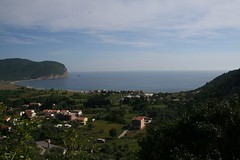
Waking up right in an old house right in front of a small-pebble beach, with no tourists yet around, had the charm of the old days when only a few rich families vacationed here and few daring travellers came by. Over a morning coffee with Djordje and his friends, we discussed the topic of little known connections in historical dates and events which we recalled from school versions of history. Saša, the descendant of the famous Stefan Mitrov Ljubiša, inspired us by his paraphrases and interpretations of Slavic connections from the time before Christ. He says that such interconnections can be traced in old balads, wall inscriptions, roots of words and local names of rivers and regions, where the ancient Slavs were settled. We were surprised by the fact that indeed in the old documents, the dating uses a different count, not counted from the birth of Christ, but according to the Byzantine calendar, which would mean that currently it is the year 7515 since the creation of the World. Is it the legend or reality that the Slavic tribes were settled on both banks of Danube ever since the sea, which covered the area, receded to create the Black Sea? Near Belgrade, in Vinče, was a settlement of old tribes, whose phonetic alphabet (not pictograms) was documented on 1500 signs found on ceramics (by professor Pešič). The script was similar to the Etrusk letters, and dated back to 5000 years before Christ. There are also similarities to the runic signs from Transylvania. They read from right to left.
As far as the present time, we can already predict a slow disappearance of the old-fashioned cyrilic script because tourism, along with west-European orientation, carries its expansive globalizing tendencies and pays no respects to specifics of local traditions and memory. Only fragments of local rarities will be surviving, such as the monastery in Buljarica, which now stands above the green expanse of a scarcely settled bay, which will soon pay for its beauty by being buried in the concrete crust of ugly tourist developments and access roads. In one of the churches of the monastery, the iconostas carries a small depiction of Saint Kristifor, a rare picture in the Balkans of a saint with an animal head. The legend says that St. Kristifor was so handsome a man, that his physical beauty overshadowed his inner beauty, and so he decided to put on the appearance of an animal, a wolf or a monkey. Even so, when he stood before Christ, he was recognized and accepted. Another legend says that he also overcame cannibalism.
No comments:
Post a Comment